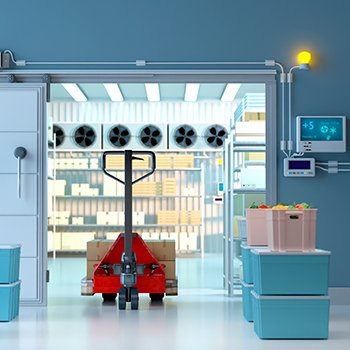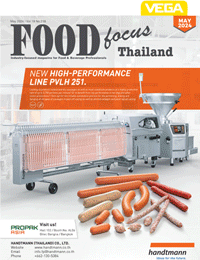แนวทางการบริหารจัดการคลังสินค้าห้องเย็นสำหรับอาหารพร้อมทาน Guidelines for Cold Storage Warehouses Management for Ready-to-Eat Foods
2771 Views |

แนวทางการบริหารจัดการคลังสินค้าห้องเย็นสำหรับอาหารพร้อมทาน
Guidelines for Cold Storage Warehouses Management for Ready-to-Eat Foods
By: ธิติ ศรีวรรณยศ
Thiti Sriwanayos
Division of Technology & Consultancy Services
Department of Food Industry Training & Consultancy
National Food Institute
Foundation for Industrial Development
thiti@nfi.or.th
แนวทางในการบริหารจัดการคลังสินค้าห้องเย็นอย่างมืออาชีพ
ผู้ประกอบการควรมีแนวทางปฏิบัติที่ดีในการออกแบบและบริหารจัดการห้องเย็นอย่างมีประสิทธิภาพ ดังนี้
1. พิจารณาถึงตำแหน่งในการจัดเก็บผลิตภัณฑ์ ปริมาณผลิตภัณฑ์ที่จัดเก็บและรูปแบบการจัดวางผลิตภัณฑ์อย่างเหมาะสม เพื่อให้ความเย็นภายในห้องกระจายได้อย่างทั่วถึง
2. พื้น ผนัง เพดาน ประตู และหน้าต่างของห้องเย็น ควรใช้วัสดุที่แข็งแรง ผิวเรียบและปิดสนิท ซึ่งจะช่วยเพิ่มความสะดวกในการทำความสะอาดและการบำรุงรักษา
3. มีการบุฉนวนกันความร้อนด้วยวัสดุที่เหมาะสมบริเวณผนัง พื้น เพดาน และประตูของห้องเย็น เพื่อให้ห้องเย็นสามารถรักษาอุณหภูมิของผลิตภัณฑ์ให้คงที่และเป็นไปตามมาตรฐานที่กำหนด
4. มีการตรวจสอบรอยร้าวของพื้น ผนัง เพดาน ฉนวนกันความร้อน หรือช่องว่างระหว่างประตู และพื้นห้องเย็นอยู่เสมอ และหากเกิดความเสียหายควรดำเนินการซ่อมแซมทันทีเพื่อป้องกันหยดน้ำเกาะบริเวณเพดานห้องเย็นในกรณีที่เป็นห้องแช่แข็ง
5. มีมาตรการป้องกันไม่ให้แมลงและสัตว์พาหะเล็ดรอดเข้าไปในพื้นที่จัดเก็บผลิตภัณฑ์
6. ใช้อุปกรณ์ทำความเย็นในห้องเย็นด้วยวัสดุที่มีคุณภาพ เช่น ระบบทำความเย็น สารทำความเย็น อุปกรณ์วาล์ว รวมถึงมีการประกอบอุปกรณ์ทำความเย็นและจัดวางแนวท่อให้เป็นไปตามมาตรฐาน
7. ระบบท่อส่งลมและการกระจายลมภายในห้องเย็นต้องสามารถส่งลมได้ไกลและทั่วถึง เพื่อให้สามารถลดอุณหภูมิภายในห้องเย็นได้ตามเวลาที่กำหนด เพื่อให้ห้องเย็นมีอุณหภูมิที่ได้มาตรฐานตามเกณฑ์ที่กำหนดและสม่ำเสมอทั่วถึงทุกจุดภายในห้อง
8. มีมาตรการตรวจสอบการรั่วไหลของสารทำความเย็นของระบบทำความเย็นอย่างสม่ำเสมอ
9. มีการติดตั้งอุปกรณ์ตรวจวัดอุณหภูมิและระบบแสดงผลอุณหภูมิในตำแหน่งที่เหมาะสม เพื่อให้สะดวกต่อการตรวจติดตามและบันทึกอุณหภูมิ ทั้งนี้อาจเลือกใช้อุปกรณ์บันทึกข้อมูลอัตโนมัติ (Data Logger) ที่สามารถจัดเก็บข้อมูลได้ในอุปกรณ์บันทึกอุณหภูมิ หรือสามารถจัดเก็บข้อมูลบนระบบคลาวด์ (Cloud Computing) เพื่อให้สามารถตรวจสอบและติดตามอุณหภูมิในห้องเย็นได้ทันที (Real Time Monitoring)
10. ควรมีการสอบเทียบและทวนสอบอุปกรณ์ตรวจวัดอุณหภูมิอยู่เสมอด้วยวิธีการและความถี่ที่เหมาะสม เพื่อให้มั่นใจว่าอุปกรณ์สามารถตรวจวัดอุณหภูมิได้อย่างความถูกต้องและแม่นยำ
Guidelines for Professional Management of Cold Storage Warehouses
Operators should have good practices in designing and efficiently managing cold storage rooms, as follows:
1. Consider the placement of stored products, the quantity of products to be stored, and the layout of products for proper distribution of cold air throughout the room.
2. The floor, walls, ceiling, doors, and windows of the cold storage room should be made of durable, smooth, and tightly sealed materials to facilitate easy cleaning and maintenance.
3. Insulate the cold room walls, floor, ceiling, and doors with suitable materials against heat transfer to maintain the product temperature stable and follow specified standards.
4. Regularly inspect for cracks or damage on the floor, walls, ceiling, insulation, or gaps around doors, and if any damage is found, repair it immediately to prevent water condensation on the cold room ceiling in the case of a freezing room.
5. Prevent insects and pests from entering the storage area with regular preventive measurements.
6. Use quality cooling equipment in the cold storage room, such as refrigeration systems, refrigerants, and valves, and ensure that the cooling equipment is assembled and arranged according to standards.
7. The air duct system and air distribution within the cold room should be able to distribute air widely and evenly to reduce the temperature inside the cold storage room as required and maintain a standard temperature throughout and consistently throughout the room.
8. Regularly check for refrigerant leaks from the cooling system.
9. Install temperature monitoring devices and display systems at suitable locations for convenient monitoring and recording of temperatures. Consider using automatic data loggers that can store data from temperature recording devices or store data in cloud systems for real-time monitoring 10. Regularly calibrate and verify temperature-measuring devices with appropriate methods and frequencies to ensure that the devices can measure temperature accurately and precisely.
10. Regularly calibrate and verify temperature-measuring devices with appropriate methods and frequencies to ensure that the devices can measure temperature accurately and precisely.






